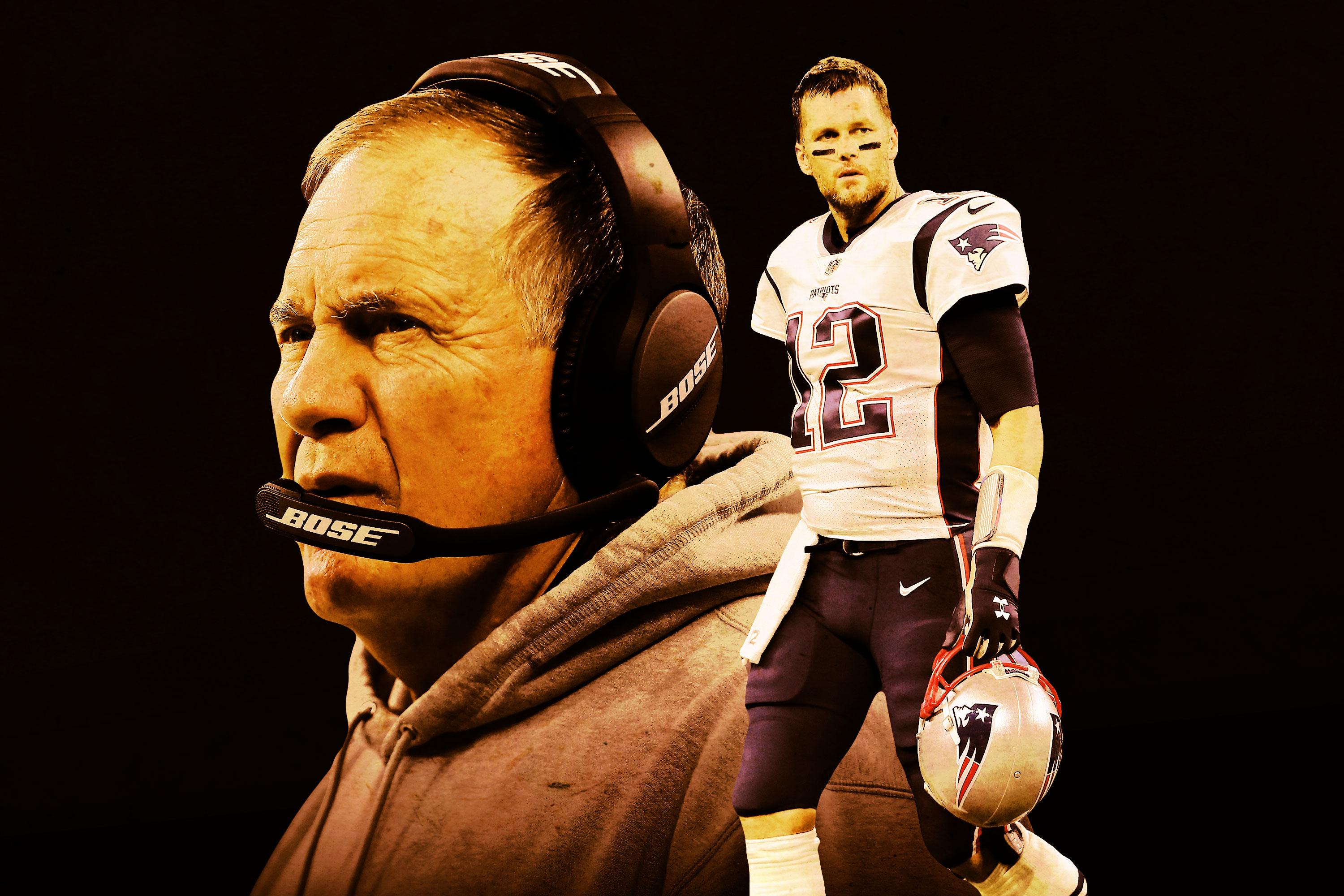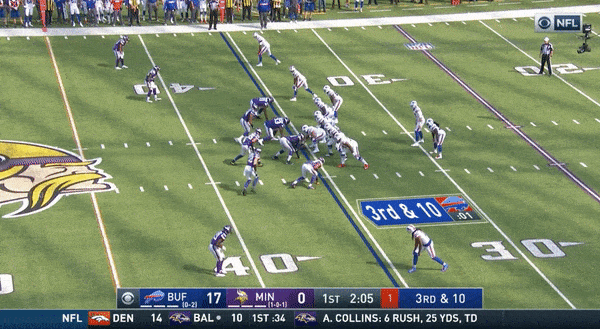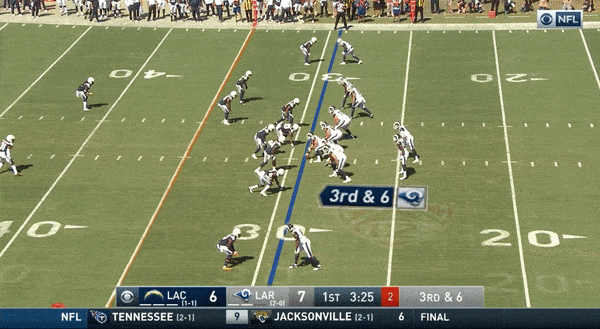The Starting 11: We’ve Seen This Patriots Movie Before
The concern trolls came for New England after Sunday night’s loss dropped the team to 1-2. But until proved otherwise, Tom Brady and the Pats are still a powerhouse in the AFC. Plus: The Rams and Chiefs look like Super Bowl contenders, and Calvin Ridley has emerged with the Falcons.
Welcome to the Starting 11. This NFL season, we’ll be collecting the biggest story lines, highlighting the standout players, and featuring the most jaw-dropping feats of the week. Let’s dive in:
1. The Patriots are 1-2 after their 26-10 loss to the Lions on Sunday, and, rightfully or not, whispers about the “beginning of the end” are coming. For the second straight week, New England’s offense fell flat. The Pats managed just one touchdown against a Detroit defense that had given up 39 points per game over the first two weeks of the season, and Tom Brady completed just 14 of 26 passes for a measly 133 yards. After trading Brandin Cooks to Los Angeles this spring and losing Julian Edelman for four games due to a PED suspension, the Patriots entered the season with one of the thinnest receiver depth charts in the league. And through their first three games, the limitations of their unique offensive scheme have been evident.
New England relies on a combination of running backs and Rob Gronkowski to carry a bulk of its receiving load, using various personnel packages to exploit matchups and create separation in the open field. With no reliable vertical threats or receivers who can consistently make contested catches, this offense runs on Brady’s precision, and his calibration has been off these past two weeks. On a first-and-10 from the Lions’ 12-yard line early in Sunday’s third quarter, running back Rex Burkhead lined up in the slot on the right, with New England in an empty formation. The Pats got the matchup they wanted—Burkhead against backup linebacker Jalen Reeves-Maybin—and Burkhead quickly got open on a fade to the corner of the end zone. Brady overthrew him by a good 3 yards. Those types of plays are the backbone of this Patriots’ offense, and if Brady continues to miss those, this group is going to struggle.
But don’t expect that to happen. Sure, Brady is 41 years old, and at his age there’s always the possibility that a sudden decline is right around the corner, but we’ve been here before. Through three games this season, Brady is completing 64 percent of his passes and averaging 6.4 yards per attempt. In 2014, when the Patriots were 2-2 and coming off a blowout loss to the Chiefs on Monday Night Football, Brady was completing just 59.1 percent of his passes and averaging 5.8 yards per attempt. Rumblings about his decline started soon after. Then he went on to finish the season with more than 4,100 passing yards and 33 touchdowns, leading the Patriots to a 12-4 record and a Super Bowl win. There are some concerning aspects to Brady’s game right now; he’s completing 36.8 percent of his passes while pressured, and only Tyrod Taylor has been worse among qualified QBs. But this seems similar to the slow starts Brady and the offense have had over the years.
Also in Brady’s favor are the additions—old and new—that he’ll get at receiver in the coming weeks. Edelman will return in Week 5, and former Browns wideout Josh Gordon joined the team last week via trade. Through three games, New England’s receivers have struggled to get separation and influence defenses vertically. In Edelman, Brady will get his most reliable pass catcher back in the fold, and Gordon’s speed could give this offense an element it’s been lacking since Cooks’s departure. Plus, Gordon’s presence down the field should give New England’s space players even more room to work with underneath.
Phillip Dorsett tied Rob Gronkowski for the team lead with five targets Sunday, but he finished with no receptions. On Brady’s final pass of the game, he was looking for Dorsett deep down the right sideline. Cornerback Darius Slay ran step for step with Dorsett down the field, and eventually the ball fell to the turf. That play was indicative of how futile the offense has looked so far this season, but more than likely, this is a minor blip that will be forgotten by December. Playoff competition at the top of the AFC is virtually nonexistent, and the situation will have to get much worse in New England before any fear starts to creep in.
2. The Vikings had the game from hell in their 27-6 loss to the Bills. Every so often, a team plays a game that seems dictated by Murphy’s law, and for Minnesota, one of those came Sunday against Buffalo. The Vikings dug themselves an early 10-0 hole as QB Kirk Cousins lost two fumbles deep in his own territory, and it only got deeper from there. Despite Cousins’s great start to the season, he had a rough day against Buffalo: Along with the fumbles, Cousins forced a pass over the middle to Latavius Murray midway through the third quarter that was intercepted, and he missed some touch throws that he’d made during his first two games with the team.
Minnesota may have unraveled Sunday, but the Bills helped the process along. Most of Josh Allen’s passes in his first career start were short, simple throws designed to let his receivers make plays after the catch. But his ability to escape pressure and do damage as a scrambler led to some deflating moments for Minnesota’s defense. On a third-and-9 late in the first quarter, the Vikings brought a five-man pressure. Buffalo’s line and running back Chris Ivory picked up each rusher during the initial surge, which allowed Allen to squirm through the line into the open field. As he neared the first-down marker, Allen leapt over linebacker Anthony Barr and picked up the first down. Two key third-down conversions in the first half and the Bills’ first touchdown of the game all came on Allen scrambles.

On the other side of the ball, Bills defensive end Jerry Hughes tormented the Vikings. Hughes was a terror off the right edge Sunday, finishing with one sack, two quarterback hits, a forced fumble, and a league-leading 10 hurries, according to Pro Football Focus. He was a fixture in the Vikings backfield, and teammate Lorenzo Alexander wasn’t far behind. They both had a big hand in Cousins’s forgettable day.
3. The Rams and Chiefs have emerged as the strongest teams in their respective conferences. Three weeks into the season, both of these clubs have rolled through opponents with terrifying ease. Kansas City put up 35 points in the first half Sunday on its way to a 38-27 win over the 49ers. Rams QB Jared Goff cooked the Chargers defense and finished with 354 yards passing and three touchdowns in a 35-23 win.
I’m not sure how much is left to say about what Patrick Mahomes II has accomplished so far this year. The Chiefs offense is a weekly spectacle, and he’s running the show about as well as any quarterback could. His 13-yard touchdown pass to Demetrius Harris late in the second quarter against the Niners featured some advanced QB tactics: After looking off the free safety by focusing on the two receivers to his right, Mahomes came back to the other side of the field, where a wide-open Harris was sprinting up the seam. The team’s combination of explosive athletes, brilliant route designs, and high-level QB play has turned this group into an unstoppable force.
In the NFC, the Rams offer a fascinating point of contrast. While Kansas City deploys an endless array of staggeringly athletic talent, the Rams receivers survive on route-running savvy and a scheme that creates room for them to operate. Brandin Cooks is a burner who can threaten any defense over the top, but Robert Woods ran a 4.51 in the 40-yard dash before the 2013 draft and Cooper Kupp’s 40 time at the combine puts him in the 13th percentile among receivers. Both guys thrive in head coach Sean McVay’s offense because of how well they understand spacing and angles and their ability to alter their speed at the right moments. Woods finished Sunday’s game with 10 catches for 104 yards and two touchdowns, and the Rams proved yet again that they can beat you with a different pass catcher any given week.
Goff has also shown significant progress in the past year under McVay’s tutelage. Some of the hole throws he made Sunday weren’t available to him last season. With 1:40 left in the second quarter, he placed a ball to Woods on the right sideline—just over cornerback Casey Hayward in the flat and just in front of the closing safety—that was about as picturesque a throw as an NFL quarterback can make. Goff is still only 23 years old. As he continues to improve, this offense should become even better than the unit that led the NFL in scoring last season.
4. The NFL’s enforcement of roughing-the-passer penalties has gotten out of control. This past offseason, the league instituted a new rule that would penalize defenders for using “most or all of their body weight” when hitting a quarterback. Defensive players are also now responsible for “avoiding landing on the quarterback” when taking him to the ground. The rule was created in part because of the hit that broke Aaron Rodgers’s collarbone early last season and kept him out for the majority of the year, which is ironic, because the Packers have suffered from its effects more than any other team this season. Against Minnesota in Week 2, Clay Matthews applied a clean-looking hit to Kirk Cousins that drew a flag, allowing the Vikings to continue their drive and send the game into overtime. Sunday, Matthews was flagged again for a textbook tackle on a sack late in the third quarter, just a few minutes after Redskins defensive tackle Da’Ron Payne wasn’t penalized for body-slamming Rodgers into the turf.
If that Matthews tackle violates a rule, then that rule is wrong. Trying to prevent defenders from picking up quarterbacks and driving them into the turf is a worthwhile effort, but legislating how much of player’s body weight falls onto the quarterback during a routine sack is not. During the Dolphins’ 28-20 win over the Raiders on Sunday, defensive end William Hayes tried to avoid falling on Derek Carr while completing a sack. Hayes’s last-second reaction caused his foot to twist in the turf, and the result was a torn ACL. Penalizing helmet-to-helmet hits and shots on defenseless receivers is beneficial to the game; whatever the league is trying to accomplish with this rule is not.
5. With Baker Mayfield and Josh Rosen both coming on in relief this week, all four top-10 QBs from this year’s draft seem poised to take over as their teams’ starters. I’m glad we got that months-long charade of coaches and decision makers around the league trying to convince everyone that their prized QBs would benefit from a season on the bench. That was fun.
Even before Tyrod Taylor left Thursday night’s game against the Jets with a concussion, it was obvious that the Browns needed to hand the keys to Mayfield. Taylor was languishing in his first season with coordinator Todd Haley, and from the moment Mayfield stepped into the game in the second quarter, Cleveland’s passing attack transformed. The Browns drafted Mayfield no. 1 overall because they thought he was a transcendent talent in a crop full of stellar passers, and his first stint under center showed why. Mayfield fit throws into the tiniest of windows and shredded the middle of the defense. His confidence is overflowing, and he’s a better quarterback for it. Going to Mayfield got the Browns their first win in almost two years, and it might have also saved their season.
Rosen’s debut wasn’t quite as thrilling. The Cardinals waited until the 4:31 mark of the fourth quarter, trailing the Bears 16-14, to throw Rosen in against Khalil Mack and a stout Chicago defense. Rosen’s first drive—and Arizona’s hopes—ended with an interception by cornerback Bryce Callahan. It was an inauspicious start to Rosen’s career, but Arizona announced Monday that he’ll start against the Seahawks, so now he’ll have an entire week of practice to help breathe some life into this listless Cardinals offense.
6. The decaying relationship between the Seahawks and Earl Thomas has created a wild situation in Seattle. This weekend, reports trickled out that the star safety skipped practice last week because of lingering frustration over his lack of a new contract. To make things even more interesting, Thomas picked off two passes on Sunday in the Seahawks’ 24-13 win over the Cowboys—the team that, earlier in the season, had reportedly tried to land him in a trade. Following one of those interceptions, Thomas bowed to the Cowboys’ bench, seemingly sending Dallas a proverbial middle finger for not following through with the deal. After the game, Thomas addressed the missed practices, saying, “I’m invested in myself. If they was invested in me, I would be out there practicing. But if I feel like anything—I don’t give a damn if it’s small, I’ve got a headache—I’m not practicing.” Well then!
So, to summarize: Thomas skipped two practices, openly taunted an entire organization because they didn’t trade for him, and told reporters that if he didn’t feel like practicing, he wasn’t going to. I can’t recall a more bizarre week for an NFL player. Rather than following Le’Veon Bell’s blueprint of holding out and forfeiting game checks, Thomas is playing while openly trying to get himself traded. Seattle’s hands are tied because when Thomas is on the field, he’s still the best player on an otherwise shoddy defense. The Seahawks can’t afford not to play him, so the best they can do is hand out a few fines for skipping practice and move on. In a league where players don’t always have clear ways to gain leverage, Thomas is proving how invaluable he is while telling the Seahawks to go kick rocks.
7. The Lions’ young offensive playmakers are starting to figure out their roles, which is bad news for the rest of the NFC. In Sunday’s win over the Patriots, rookie running back Kerryon Johnson was the Lions’ first 100-yard rusher in nearly five years. The Auburn product finished with 101 yards on 16 carries while also adding two receptions. He got the same workload as bruiser LeGarrette Blount, who managed just 48 yards on the same number of carries. The Lions sport a multifaceted backfield with Johnson, Blount, and receiving back Theo Riddick, but Sunday’s game showed that it’s time to cede the majority of snaps to Johnson. Blount and Riddick have such defined roles that the offense becomes predictable when they’re in the game—Johnson’s abilities as a receiver allow him to do it all, and it’s clear that he’s the best hope for this ground game.
The Lions’ pass-catching unit has continued to improve, as well. Kenny Golladay showed flashes during an injury-riddled rookie season in 2017, but this fall he’s fully emerged. Golladay tallied six catches for 53 yards and a touchdown against New England, his fourth consecutive game with either 100 yards receiving or a touchdown. And even in a group that includes Marvin Jones Jr. and Golden Tate, Golladay might be in the conversation as Detroit’s most dangerous receiver. At this point, Matthew Stafford has more viable pass-catching options than he knows what to do with.
8. Calvin Ridley is the piece that the Falcons’ offense had been missing. The first-round pick out of Alabama finished with seven catches for 146 yards and three touchdowns in Atlanta’s 43-37 overtime loss to New Orleans on Sunday, and he’s starting to flame cornerbacks in the red zone. Ridley’s first touchdown of the day came on a nasty hesitation double move on the outside that left him wide open for an 18-yard score, and he worked cornerback P.J. Williams for most of the game. His route-running ability is already more fine-tuned than you’ll see from most young players. With Julio Jones attracting so much attention on the other side of the field, Ridley is often left in man-to-man coverage, and he’s shown just how much of a problem he can be in those situations.
9. This week in tales of the tape: The Rams use stacks and bunches to create space for their receivers better than any team in the league. Facing a third-and-6 late in the first quarter this week, the Rams came out in the shotgun with four wide receivers. After initially aligning in the slot on the left side, Cooper Kupp motioned across the formation and set up in a two-receiver stack with Robert Woods on the right side. At the snap, Kupp delayed his release to allow Woods to clear out the cornerbacks on that side. With Woods streaking down the seam, Kupp worked a quick angle route underneath, hauled in a short throw from Jared Goff, and gained 11 yards for the first down. It may seem like a simple concept, but these are the types of wrinkles that make the Rams so difficult to defend.

10. This week’s line-play moment that made me hit rewind: J.J. Watt looked like his old self on Sunday. Watt was flat-out dominant in the Texans’ 27-22 loss to the Giants. He collected three sacks, four tackles for loss, four QB hits, and a forced fumble while pummeling replacement right tackle Chad Wheeler. Watt’s quick inside swim move against the run is nearly impossible to stop when it’s timed right, and he had it working to perfection against the Giants.
11. This week in NFL players, they’re absolutely nothing like us: As if Mahomes needed any more help, Travis Kelce is out here making catches like this.